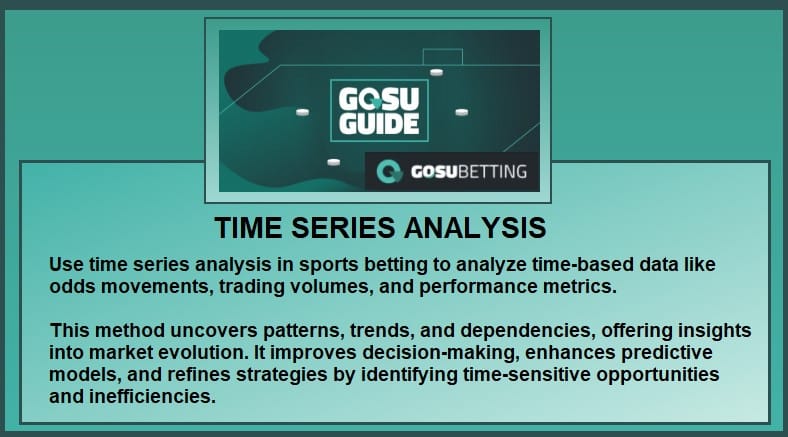Bettors looking for an edge will be well-advised to use the lessons of the past to give greater chances of success in the future. Time Series Analysis provides us with the tools and techniques to analyze historical data and identify patterns and trends that can help in our attempts to beat the sports betting markets. This analysis forms a major part of valuable betting strategies.
What is Time Series Analysis?

Time series analysis is the process of analyzing data points that are collected sequentially over time. The data can be used to identify patterns and trends in sports performance.
This form of temporal modeling or longitudinal analysis uses time-dependent data to extract patterns that would otherwise be invisible. We are interested in data-sequencing to perform effective analysis.
Time series analysis allows bettors to understand historical trends, identify patterns of success (or failure), and use this to forecast future outcomes.
The Foundation of Historical Data
Time series analysis is heavily reliant on historical data, including past sports outcomes and associated metrics that can be organized chronologically. This collection of time series data points, also known as past performance metrics, is key to a thorough analysis.
We are looking at time-ordered data and longitudinal datasets, and trying to understand how these factors change over time.
Access to and organization of detailed historical data is essential for time series analysis.
Trend Analysis and the Identification of Patterns
Trend analysis allows for the identification of long-term movements in the data by examining long-term trends. This is also known as pattern discovery.
This method of highlighting patterns helps to understand the general direction and movement of the data over time and is also known as directional movement and secular trends. Detecting trends and spotting persistent patterns gives a useful model that can help predict the future.
Seasonality and Recurring Patterns
Seasonality refers to identifying recurring patterns that repeat over regular intervals, such as yearly or weekly variations. This identification of cyclic patterns and periodic fluctuations helps to reveal time-based fluctuations.
Autocorrelation: Patterns in Previous Data
Autocorrelation reveals how a time series relates to its own past values, and is a form of serial correlation.
Understanding this temporal dependence is essential, and helps to identify where previous data is likely to influence the present results.
This activity is a core aspect of understanding time series relationships and is sometimes called self-correlation. It’s achieved by using lagged data to perform pattern identification.
The results help to identify if there is any temporal dependence between data points and how significant that may be. We use this to understand how the previous data impact current results and understand serial dependence.
Forecasting Models: Predicting the Future
Forecasting models are mathematical models, also known as predictive models that are used to predict future values based on the patterns that have been identified in the historical data. These models seek to make time-series predictions based on statistical forecasts.
A core objective is to improve overall model accuracy and forecast validity.
Using forecasting models, bettors can move from an analysis of the past to making predictions about the future.
Lagged Data and Autocorrelation
Lagged data represents the data points from a time series where data is offset by a certain amount of time. This can help reveal time lags and how the prior observations influence the present.
When analyzing past time values, we are looking at offset time data.
Understanding time lags can help improve forecasting by revealing the impact of historical time points and the effects of time-shifting data.
Trend Detection and Pattern Recognition
Trend detection, also known as pattern recognition, allows for the understanding of patterns and long run changes in the data.
We must understand long-run trend identification to get an insight into directional changes and for the underlying pattern detection. Achieving this needs a detailed assessment of trend characterization and often requires the use of data visualisation tools.
Stationarity: Understanding Consistency
The statistical property of stationarity is where the mean and variance of the data do not change over time. This allows for an assumption that the data is a good representation of the future.
To understand this we need to assess time invariant characteristics and stationary properties. We also need to ensure that the data is in a statistical equilibrium. This is assessed using time invariance techniques.
Stationarity helps to simplify the models, making them more accurate. It’s a core assumption for many time series models.
Model Evaluation for Accuracy
Model evaluation is a process that is used to assess the accuracy and reliability of time series models. This includes analysis of model performance using a range of techniques, including using error analysis to assess model precision.
By using techniques such as performance metrics to create more accurate and robust models we can improve our overall predictive performance.
Summary & Key Takeaways
By understanding and applying time series analysis techniques, sports bettors can move beyond simple past performance analysis and begin to understand the dynamic relationships between data points over time. The information obtained can be used to make more informed predictions and create stronger betting strategies.
Key takeaways associated with time series analysis include:
- Understanding Trends: Identify key trends to inform decisions.
- Recognizing Patterns: Detect recurring patterns in performance.
- Making Informed Predictions: Use data-driven insights for better forecasting.
- Improving Models: Constantly evaluate and improve your models over time.
- Unveiling Hidden Insights: Reveal patterns that are otherwise invisible in static data points.
By incorporating these techniques, we can greatly improve our understanding of the factors influencing sporting events and the markets in which we can bet, allowing us to build stronger, more reliable, betting strategies.
If you’ve already highlighted some strong data that you feel can support your sports betting predictions and need somewhere to try it out with some carefully placed wagers, this list of GOSUBetting recommended crypto sportsbooks below contains bookies that come highly recommended after extensive testing:
Top Bitcoin Betting Sites
BC.Game
Welcome Bonus: Four-part deal up to $1,600
18+ – Gamble responsibly – GambleAware.org – T&C’s apply




